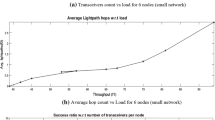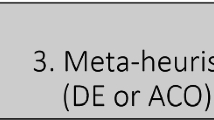Abstract
In IP-over-wavelength division multiplexing networks, a virtual topology is placed over the physical topology of the optical network. Given that a simple link failure or a node failure on the physical topology can cause a significant loss of information, an important challenge is to make the routing of the virtual topology on to the physical topology survivable. This problem is known as survivable virtual topology mapping (SVTM) and is known to be an NP-complete problem. So far, this problem has been optimally solved for small instances by the application of integer linear programming and has been sub-optimally solved for more realistic instances by heuristic strategies such as ant colony optimization and genetic algorithms. In this paper, we introduce the application of differential evolution (DE) to solve the SVTM problem and enhancements based on DE are proposed as well. Three algorithms based on DE are developed. The enhanced variants have better convergence rate, get better quality of solutions and require few control parameters. We present the impact of these parameters on the system’s performance improvement. Algorithms are evaluated in different test bench optical networks, as NSFnet and USA, demonstrating that the enhanced DE algorithm overcomes the other two, for small instances. The three algorithms reach a 100 survivable mapping for small instances. The three algorithms also find positive survivable mappings and reduce the network wavelength links. Results show the effectiveness and efficiency of the proposed algorithms.












Similar content being viewed by others
References
Kaldirim, E., Ergin, F.C., Uyar, S., Yayimli, A.: Ant colony optimization for survivable virtual topology mapping in optical WDM networks. In: Symposium on Computer and Information Sciences (ISCIS), pp 334–339, (2009)
Zhou, D., Subramaniam, S.: Survivability in optical networks. IEEE Network, 14(6), 16–23 (2000)
Sahasrabuddhe, L., Ramamurthy, S., Mukherjee, B.: Fault management in IP-over-WDM networks: WDM protection versus IP restoration. IEEE J. Select. Areas Commun. 20(1), 21–33 (2002)
Mukherjee, B.: Optical WDM Networks. Springer, New York (2006)
Modiano, E., Narula-Tam, A.: Survivable lightpath routing: a new approach to the design of WDM-based networks. IEEE J. Select. Areas Commun. 20(4), 800–809 (2002)
Todimala, A., Ramamurthy, B.: A scalable approach for survivable virtual topology routing in optical WDM networks. IEEE J. Select. Areas Commun. 25(6), 63–69 (2007)
Ducatelle, F., Gambardella, L.M.: A scalable algorithm for survivable routing in IP-over-WDM networks. In: Proceedings of the International Conference on Broadband Networks (BroadNets), pp 54–63 (2004)
Kurant, M., Thiran, P.: Survivable mapping algorithm by ring trimming (SMART) for large IP-over-WDM networks. In: Proceedings of the International Conference on Broadband Networks (BroadNets), pp 44–53 (2004)
Ergin, F.C., Yayimli, A., Uyar, A.S.: An evolutionary algorithm for survivable virtual topology mapping in optical WDM networks. In: Applications of Evolutionary Computing. volume 5484 of Lecture Notes in Computer Science, pp. 31–40. Springer, Berlin/Heidelberg (2009)
Ergin, F.C., Kaldirim, E., Yayimli, A., Uyar, A.S.: Ensuring resilience in optical WDM networks with nature-inspired heuristics. IEEE/OSA J. Opt. Commun. Netw. 2(8), 642–652 (2010)
Storn, R., Price, K.: Differential evolution—a simple and efficient heuristic for global optimization over continuous spaces. J. Glob. Optim. 11(4), 341–359 (1997)
Vesterstrom, J., Thomsen, R.: A comparative study of differential evolution, particle swarm optimization, and evolutionary algorithms on numerical benchmark problems. Proc. Congr. Evol. Comput. (CEC) 2, 1980–1987 (2004)
Das, S., Suganthan, P.N.: Differential evolution: a survey of the state-of-the-art. IEEE Trans. Evol. Comput. 15(1), 4–31 (2011)
Lezama, F., Castañón, G., Sarmiento, A.M.: Differential evolution optimization applied to the wavelength converters placement problem in all optical networks. Comput. Netw. 56(9), 2262–2275 (2012)
Lezama, F., Castañón, G., Sarmiento, A.M.: Survivable virtual topology mapping in IP-over-WDM networks using differential evolution optimization. In: Proceedings of the International Conference on Transparent Optical Networks (ICTON), pp 1–4 (2013)
Banerjee, N., Sharan, S.: A evolutionary algorithm for solving the single objective static routing and wavelength assignment problem in WDM networks. In: Proceedings of the International Conference on Intelligent Sensing and Information Processing (ICISIP), pp 13–18 (2004)
Jin, Y.: Yen.: finding the k shortest loopless paths in a network. Manag. Sci. 17(11), 712–716 (1971)
Author information
Authors and Affiliations
Corresponding author
Rights and permissions
About this article
Cite this article
Lezama, F., Castañón, G., Sarmiento, A.M. et al. Survivable virtual topology mapping in IP-over-WDM networks using differential evolution optimization. Photon Netw Commun 28, 306–319 (2014). https://doi.org/10.1007/s11107-014-0455-1
Received:
Accepted:
Published:
Issue Date:
DOI: https://doi.org/10.1007/s11107-014-0455-1




